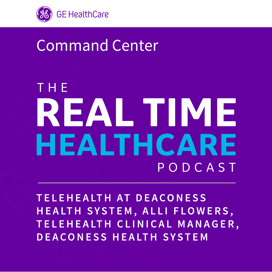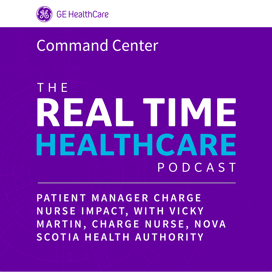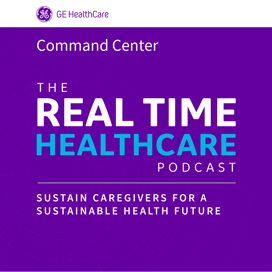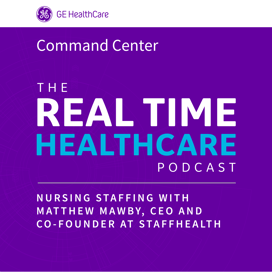In this Episode:
Serving a large geographical area across four states, Deaconess Health System is evolving their telehealth programs to help them deliver care to all who need it. Alli Flowers, Telehealth Clinical Manager at Deaconess shares, “I think ultimately everyone appreciates the flexibility [of telehealth] and being able to treat patients where they're at and when they need it.”
In this episode, she talks about the technology that supports their telehealth programs, including their D-Care Command Center. “I was introduced to D-Care and within five minutes, they were able to create a profile for us to identify potential candidates for remote monitoring as well as where those patients are at with their care,” said Alli.
Deaconess is committed to extending services across the broad area they serve so that people do not go without care. Alli shares more details, including how one innovative program leverages a partnership with an area university and local libraries to offer accessible telehealth services in rural communities.
Jeff: Hello and welcome. I'm Jeff Terry. Delighted to be joined today by Alli Flowers, who is the Telehealth clinical manager for Deaconess Health System, which is a six or eight or ten hospital integrated delivery network out of Evansville, Indiana, serving the Tri-State and I think becoming a four-state area around southern Indiana. Alli, thanks so much for joining.
Alli: Yes, thanks for having me.
Jeff: Awesome. So we're going to talk a little bit about the telehealth modalities that you guys provide for patients through Deaconess, the technology you use. Talk a little bit about how your D-Care Command Center supports that and then get your take on the future of telehealth. But maybe to start a bit with that, I mean telehealth, virtual care, digital health, e-health, like it's sort of all the talk, clearly a hot area so much it evolved quickly through COVID and so forth. But maybe just to start, like when I say telehealth, telehealth is in your title. What is telehealth to you, to Deaconess? What does it mean?
Alli: So to me, telehealth is just another way to connect with patients where we're not necessarily physically touching them, but we're still connecting with them and providing care. So more of just an extension of any care that we offer.
Jeff: And that can take a lot of forms, as you've schooled me on. So maybe for the audience, what are the telehealth services or modalities that you guys provide today?
Alli: Yep. So I think the highest level that everyone is very common, commonly known is just an audio video connection where you can see and hear each other just like we are today. And you can see your provider, talk to them and receive treatment. Below that there are just telephone visits. So sometimes we just have audio only visits depending on what it is, and then e-visits where you just fill out a form and receive treatment. So there's lots of lots of different ways to connect with patients.
Jeff: So an e-visit you think of as the form, the telehealth is the face to face through something like Zoom that we're doing. And then what are the sort of the clinical services I think you mentioned? Tele-neuro, tele-stroke. Like what? How has your program evolved clinically?
Alli: So yes, So just in the past 4 to 6 months, we did launch a tele-stroke and Tele-Neurology program where we're able to connect with patients at some of our rural hospitals and treat them before they're out of time actually to receive treatment. So we did start that and then just our normal primary care and specialty care providers, they intermingle video visits within their normal schedule.
Alli: So they might have a patient come in person and then the next visit could be a video visit. So we do different things like that. We also do our emergent site consults. We do a lot of those over video as well, so we can serve a lot of facilities that do not have access to that type of treatment.
Jeff: And you mentioned particularly after hours that service is of even higher value.
Alli: Yes, less staff. And so they're able to cover more facilities by using video technology.
Jeff: And you also mention, I think remote patient monitoring is a service you provide.
Alli: Yes. So we do remote monitoring and we are really focused on patients with heart failure and COPD that are high risk for readmission to help them just stay at home where they're comfortable and manage their condition.
Jeff: May I ask I mean, I think clearly we all have a sense that this is good, you know, but you know, it's better for the patient, better If you can stretch the provider's expertise to many more patients, it's lower cost if we do it right. But I mean, you hear it on the front lines. What do you hear from providers and patients directly about these programs? How do they respond?
Alli: So I think it depends, but most patients appreciate. I'm going to start with the patient side instead of the provider. So I think the patients appreciate the flexibility with telemedicine. So less time away from work, child care, drive time, all of those things are help them overcome those obstacles because of telehealth. Providers I think are the same. You know, there are certain conditions because obviously not everything can be treated over telemedicine, but for those things that can, I think the providers appreciate that too.
Alli: So if they were typically driving an hour and a half to a remote clinic to see patients, now they can stay back at their office and still provide service for that community and not have that drive time. But I think ultimately everyone appreciates the flexibility and being able to treat patients where they're at and when they need it.
Jeff: Absolutely. And so there's different. And so next thing to ask about is the technology that you use and I mean the technology to enable that patient provider interaction. And I think it varies a little bit by modality. So could you describe that?
Alli: So we actually use it for like our primary care and specialty care visits we use. We have an epic shop, so we use epic video client and that is the experience I feel like for the patient and the provider is really good with that because they can launch their visit directly from their schedule. So that's how it's easy for them to go from an in-person to a video visit.
Alli: And then on the patient side, they're launching their visit directly through their MyChart app. So it's easy for them as well. Their instructions are right there, tells them exactly what to do. For our other services, like Zoom, we use Zoom. So for our mental health consults and we actually use it for some different things. But it's just really an iPad to iPad connection.
Alli: So it's not expensive to be able to support those programs. And you just basically have an iPad on a cart and wheel it in and they're able to connect in.
Jeff: Is that in what setting is that patient and is that patient in a residential home?
Alli: So typically for this Zoom connection, it would be the patient would be at another hospital, maybe in an emergency room if they're getting an emergent site consult. So at another facility. So there is staff there.
Jeff: And so you can so you have the cart prepared to. Yes.
Alli: Yes.
Jeff: And you can you give us a sense of the scale of the program? I mean, how many visits in some of these modalities per year? What's the scale of that?
Alli: So we do track that in off the top of my head. I don't know that I can provide that, but overall, I do know our telehealth visits. So let's just talk about maybe our primary and specialty care visits. Overall, we're just right at about 2%. So our overall visit volume, just about 2% is video. So our site consults, we do track telemedicine versus in-person visits. And it's typically it depends on if the patient is in one of our rural facilities, 100% of those are going to be done over video. So it just depends on where our staff is located and where the patient is on if we can do those in person. So our bigger hospital in Evansville, a lot of those are done in person because we have staff there pretty much all the time now.
Jeff: So the programs are up and running, different technologies, enabling the interactions, you know, many of them out of Epic, Zoom, a key platform. And then you also have that a care command center which supports a lot of activity for Deaconess, but it also supports not the patient provider interaction, but it supports the management of the programs. Can you describe how DCARE supports?
Alli: Yes. So for remote monitoring, we were relying on referrals while the patient was in the hospital. So typically our case managers or we have nursing staff that can give referrals for the program as well. And as we started to sort of see a decline in those referrals, I was introduced to DCARE and within less than 5 minutes they were able to create a profile for us where we could identify any patient that is currently admitted, which we filtered on DRG and CPT codes with heart failure or COPD.
Alli: So that was huge for us because now we can see who's in the hospital with this particular diagnosis. So it's appropriate. We might get referrals for a patient that's in with maybe abdominal pain, with a history of CHF that they're not really struggling on managing that condition. So not necessarily somebody we would monitor. With this profile, we're able to see the exact patients that are admitted with those diagnoses.
Jeff: And so you're able and so that helps you drive identification of candidates that might be enrolled. And it sounds like in particular identify patients that are sort of high because of high readmission risk. They may be sort of extra appropriate for the program.
Alli: Yes, that is correct. And, you know, another really nice thing about DCARE, the particular nursing units that are using it, they make notes. So it's so easy to see exactly what's happening with the patient and where they're at in their care. You know, are they going to be here for several more days or will they be discharged within the next day or two? And that helps us decide when is when is it an appropriate time to contact them and discuss the program with them to see if they even want to participate in.
Jeff: Do you message back and forth? Does your team message back and forth to the care teams through the DCARE applications.
Alli: So not through DCARE. We we do that through EPIC. So if we do need to reach out to the case manager or the nurse, then we would just actually use Epic to do that. But for us, if they're entering notes though, we can quickly see exactly what's happening. So it's just nice. It gives us a quick overview.
Jeff: It keeps you joined up and allows you to see it, keeps you joined up and allows you to see the flow of the patients and the candidates. Yeah, that's great. And so, I mean, it kind of zooming out, which is thank you for all that and zooming out a bit. And I'm interested in your view of how this space will continue to evolve.
Jeff: And what I mean by that as we've got sort of, you know, telehealth, which is, you know, face to face through video, we've got e-visits, which is sort of the recording, the forms. We've got, you know, virtual care, which increasingly is a term people use, people use the term digital health. So you bring it down to the program level where you have emergency psych through telehealth.
Jeff: You have tele-neuro, tele-stroke, remote patient spaces and concepts and clinical services and technology and is sort of a lot it's exciting and it's sort of all for the good, but it's sort of a lot to get your head around. So I guess I'm curious how, how you think about the future of that space abroad really. And yeah, I guess broadly and also how you evaluate the next program or the next investment.
Alli: So I'll start with that. When we are looking at starting a new program, it is what is the need for the program? So we go through a whole process to evaluate is there reimbursement involved, is it sustainable? You know, can we see is there grant funding because a lot of times for telehealth there, there could be grant funding. But ultimately, when that grant ends, are you able to maintain what you've started? So that's a big thing. We don't ever just put a program out there just to have it. It is to fill a need. So why, why are we doing it?
Alli: But ultimately, I think as we've seen nationally, there's a big disparity for people as far as broadband access and it's an issue. So having that health equity, this is that that's a concern I think, for a lot of people. So I do think telehealth is only going to grow. I think it's just a normal part of care now. And ultimately that all the new technology, the new softwares that are being created every day, it's extremely interesting to watch the amount of AI that is coming out.
Alli: And even with remote monitoring over the last couple of years, it has drastically changed with the current. What we had initially when we started, which is basically you're asking the patient questions and you are collecting biometrics and you're just tracking and trending their data and trying to see if anything is going to happen. You're kind of predicting yourself where with this new AI technology with RPM, they can pretty much tell you based on this last week's information, they're more than likely going to readmit to the hospital.
Alli: So it's very different and I think we're just going to continue to see that expand as we move along and technology just continues to grow.
Jeff: Well, that really underscores sort of your point you've made a couple of times, which is, you know, you said telehealth is a normal part of health. You say telehealth is just health care, right? It's not yes, it's not a separate category. It's just part of health care. And in that regard, it makes complete sense that, you know, the AI that's being applied to spot patterns and save time and all over the place is equally applicable here.
Jeff: Can I ask one other thing that comes to mind is clearly, it seems to me that these that these capabilities are even more important in a catchment area like you serve, which is a geographically broad catchment area. How do you think about that? You mentioned health equity and yes, a little more about this sort of served the kind of catchment area that you serve and the need to push care out into the into all the corners of that.
Alli: So we're in Indiana, Illinois and Kentucky, so we do have a broad area that we are serving. And when you think about it, I actually got to travel to one of our Illinois facilities a couple of weeks ago and it was a little over 2 hours drive to get there. And when you think about that, those patients are coming to that facility and ultimately they could stay there and receive their care if they had the specialty services that they needed.
Alli: So being able to extend our specialists to them is extremely important because they're the reason we continue to expand our health system and grow is to keep that care local. Don't make those patients have to drive to receive care. So that could be in many different forms, not just in that patient being hospitalized. We can open up clinics where they could have a visit with a specialist and stay right here at their facility.
Alli: So you hear it so much and just people unable to receive care because they couldn't drive to their appointments. So it's just trying to figure that out and how we can help you extend all of our services to all locations so people do not go without care.
Jeff: Definitely. And and you said it, but, you know, when you're extending specialist care to patients that are at another one of your hospitals, that takes the sort of broadband issue off the table. Right. You have the infrastructure and then that's a great pushing all the way to the patient's home can sometimes be more challenging because of things like broadband, but nonetheless is useful in many cases, and that all those services and capabilities are I think a part of it is no secret, Deaconess is doing really well, right. Expanding across the regions, growing in that those capabilities seem strategic and ability to serve such a broad and diverse geography and population.
Alli: Yes, in something that we've been able to do that's been interesting, we partnered with one of our universities. It's the University of Southern Indiana and our local libraries. And we put equipment in the libraries and patients can go and they put them in a quiet room and they can actually do a visit there. So we want to expand that to a lot of our rural communities because that would allow patients just to have someplace close because, you know, all small towns have a library and they have access to wifi. And they have broadband. Yeah, yeah, that's brilliant. So now everything.
Jeff: Every library becomes a specialty clinic, basically.
Alli: Yeah. Yes. Yeah, yeah. So they can go there. The librarians are trained to help them, at least to get logged on and know where to go to start their visit, and then they leave. And that patient has privacy and they can complete their visit. So we're trying to figure out those connections and how we can help with that.
Alli: So if somebody can't even get to their hospital, at least they could maybe get to their library because a lot of them are within walking distance if you're familiar with these small towns, that they're they wouldn't even have to drive.
Jeff: Well, that's brilliant. And what a great use of the library. I mean, I know libraries sometimes are struggling these days with, you know, people obviously check out less books. And so how do they still stay relevant and high value to their communities? What a what a wonderful synergy. That's really cool. Awesome. Well, Alli, we'll leave it there.
Jeff: I think. Thank you so much for joining the podcast and talking about this.
Alli: Yes, thank you for having me.
Jeff: Awesome. Thanks again. And with that, Will, we'll close the podcast.





